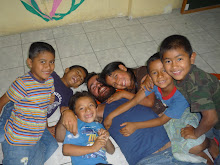(Monday, 6 July 2009)
I'm heading today to the southern hemisphere, but I'm going with Colombia in my heart.
I've written here time and time again about how much this country has positively surprised me, about how well impressed I am with its natural and cultural diversity and beauty, with the genuinely welcoming way of being of its people.
So my last thoughts go to what I didn’t get to know…
The Amazon basin for instance, as unfortunately much of it (not all, but most of it) is still not accessible to travellers as it’s still cocaine and guerrilla territory.
Or coastal towns by the Pacific, where poverty and desperation lead to drug smuggling, violence and crime at levels not seen in many other places in the world. For instance, Tumaco is a relatively small town of around 85,000 people which lies in territory half-forgotten by the government, and is in the middle of a war between rival gangs, who fight for the control of drug shipping up north, to the US, via Mexico and other Central American countries. That’s a town where desperation leads people to embark on several weeks-long journeys through the Pacific Ocean, on hand-made submersibles of wood and fibre glass, that try the dangerous trip to the northern waters of Mexico, loaded with cocaine and below the eyesight of the authorities. Needless to say, many die in that attempt. That’s a town where, on average, 4.4 people are murdered every day. Given Tumaco's size, that represents a homicide-rate 15 times (!) higher than that of Caracas, currently considered the most dangerous city in the world not-at-war. Needless to say, Tumaco is not accessible to travellers either.
These are consequences of the “dark side” of Colombian politics, power struggles and war. The “dark side” of a country where there is a very unclear border line between governmental forces and the paramilitary. The “dark side” of a country where it’s actually not only the government being accused of promiscuous relationships with the paramilitary, but the all parliament, as politicians from all parties and movements have been found to have accepted money from the drug trade to finance their campaigns – only so that they can pay it back with political and economic favours later on (what is called around here as the “para-politica”).
Before I travelled here, the image I had of Colombia was really dark. Now, it’s much brighter, much more colourful and warm in my heart. And I now understand a bit better the darker aspects of the Colombian reality (because I know they exist!), what makes them dark, and why it’s only that darkness that comes across to the foreign public.
So, my wishes are that when someday I come back – right now I feel like how couldn’t I? – I find a country that managed to solve its problems, that I can get to know freely and peacefully places like the Amazon basin or Tumaco. But also a country that managed to make that happen without incurring in the power abuses that seem to become common place nowadays.
Bye-bye, Colombia. All the best, and see you soon!
(P.S.: “Semana” seems to be a very good weekly magazine to keep up to speed with what is happening in Colombia – a lot of chronicles, opinionated texts and research-based journalism that seem to be fairly independently minded)
Saturday, 18 July 2009
Subscribe to:
Post Comments (Atom)

No comments:
Post a Comment